And we continue our short and quick tour in Hatshepsut Mortuary Temple in Luxor’s Deir El-Bahry in February 2012.
You can refresh your memory and see more about the history of the famous Egyptian Queen’s temple and the history of its excavation as well as the first lower floors or courts in the temple itself in the first part of this two-series post.
 |
| On the way to Hatshepsut temple in Deir El-Bahry |
An important disclaimer: I included here only the parts I have seen in this huge complex. There are even more parts that I missed.
Now to the middle of the second terrace or the court which you reach through a ramp from the lower terrace or court.
 |
| The middle terrace of Hatshepsut mortuary temple |
The middle terrace measures 75m deep by 90 m wide according to Wikipedia and it is fronted by colonnades. There are lots of details on this terrace.
When you turn around, you see the amazing scene of the valley as well as the vast green countryside of Luxor on the horizon.
I bit it was one hell of a scene when it was built thousands of years ago.
 |
| The scene from the middle terrace at Hatshepsut temple |
Now turn back because we are still in that middle terrace and its colonnades aka porticoes “I learned a new term in this post”.
The west porticoes or colonnades contain 22 columns arranged in two rows and it is commonly known as Punt Porticoes and besides a shrine for ancient Egyptian deity Hathor.
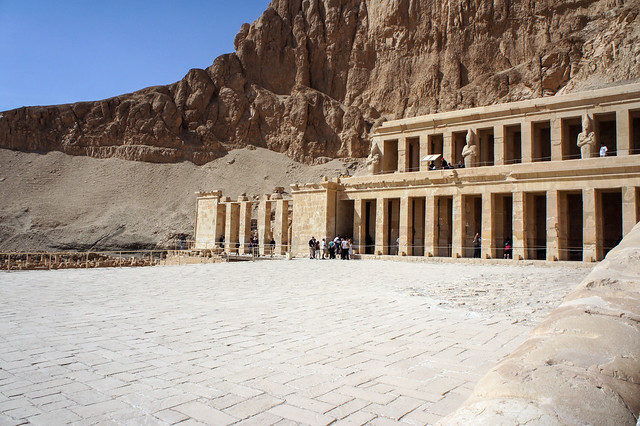 |
| The punt porticoes and Hathor Shrine at Hatshepsut Mortuary temple's middle terrace. |
The scene in the heart of the rocky mountain is breathtaking
First, let’s stop at the Punt Portico.
If you are familiar with the ancient world, especially ancient Africa and the history of Queen Hatshepsut, you will recognize “Punt” and its significance in her life and achievements.
 |
| The Punt portico at the middle terrace of Hatshepsut mortuary temple |
Punt or rather the land of Punt is an ancient civilization in the Horn of Africa and it is widely believed to be Somalia.
The relations between ancient Egypt and the Punt civilization is one of the earlier international trade relations in the ancient world I believe because it recorded that ancient Egyptians had trade relations with the land of Punt since the fifth dynasty of the Old Kingdom.
During her reign, Hatshepsut built a Red Sea fleet “ The Ancestors of Modern Egyptian Navy’s Southern Fleet as it seems” made of five ships to exchange Punt’s mortuary goods “All that for death rituals” in exchange for Nubian gold. “Maybe they got more goods than animal skins and exotic incenses”.
The “Punt expedition” was a huge political, economic and diplomatic success for the Queen as it seems because it was recorded as one of her huge successes in her era in her own mortuary temple.
Now to Hathor Shrine.
At the far end of the Punt Portico or the South end of the middle terrace, there is a shrine dedicated to the ancient Egyptian deity Hathor.
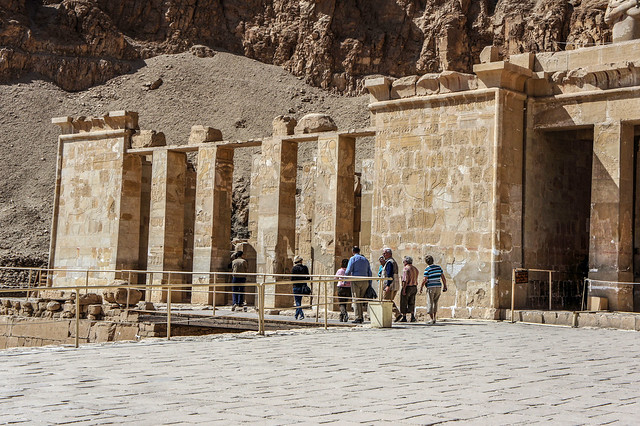 |
| The Hathor shrine at the middle terrace of Hatshepsut mortuary temple |
If you zoom in you can see the remains of the ancient scene showing Hatshepsut feeding Hathor as a cow.
It is actually separated from the main mortuary temple that is fully dedicated to Amon-Ra.
Unfortunately, I did not go inside to see those details and I feel sad but hopefully inshallah I will make it again.
That part was vast and you can see the excavation digs in the mount surrounding the temple so clearly at least in 2012.
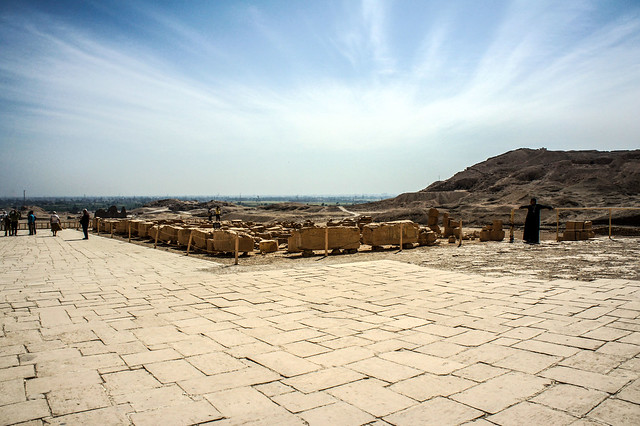 |
| The view from the middle terrace, you can see the green fields of Luxor from there |
I will speak about that part later
To the Northside of the court with its many details.
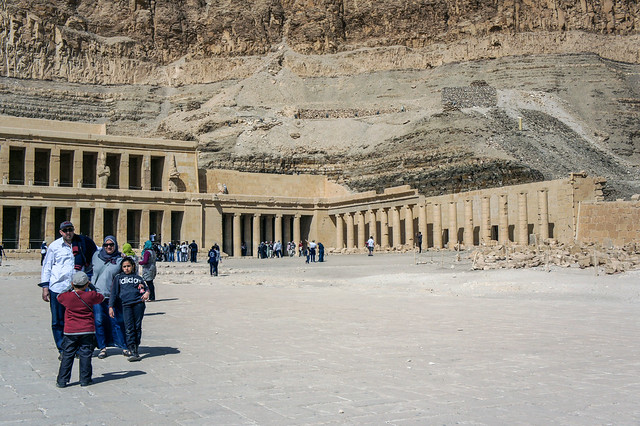 |
| The north portico and Anubis shrine at the middle terrace of Hatshepsut temple |
The north portico in the court is made of 15 columns in a single row.
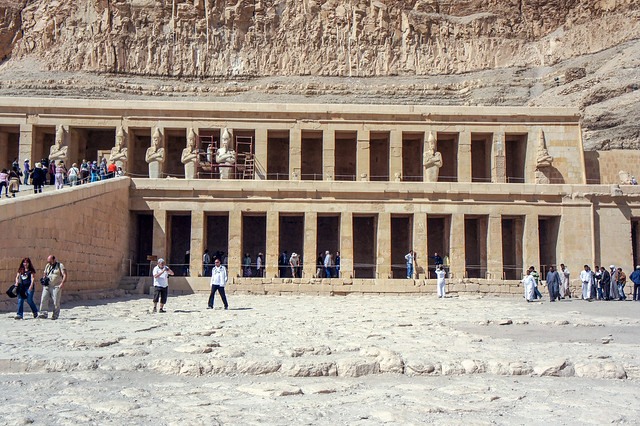 |
| The north portico at the middle terrace of Hatshepsut temple |
This portico or colonnade features a scene showing the divine birth of Hatshepsut to King Thutmose I as Amon-Ra and Queen Ahomse.
According to archaeologists, that scene legitimized her rule.
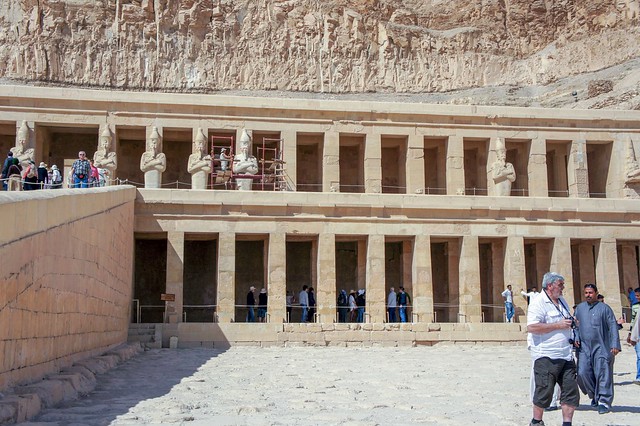 |
| The north portico at the middle terrace of Hatshepsut temple |
Unfortunately, I had not seen that scene but I read that it was the oldest of its style and other kings followed her step and copied that scene.
Maybe she copied it herself considering how the Kings were believed to be the son of Ra in ancient Egypt..etc.
After the portico or colonnade, there is a shrine dedicated to the ancient Egyptian deity Anubis.
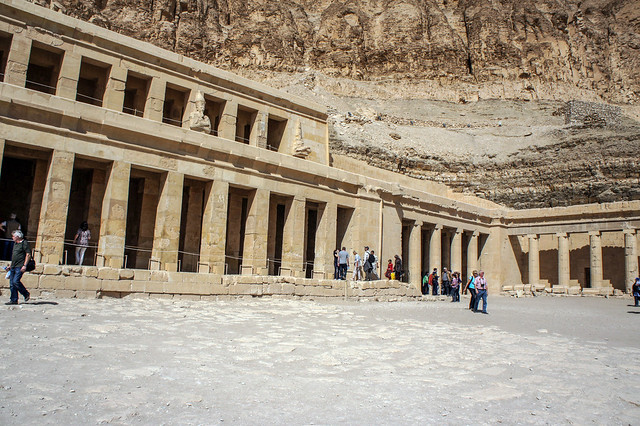 |
| Anubis shrine beside the North portico of the middle terrace |
It is smaller than the Hathor shrine on the other side.
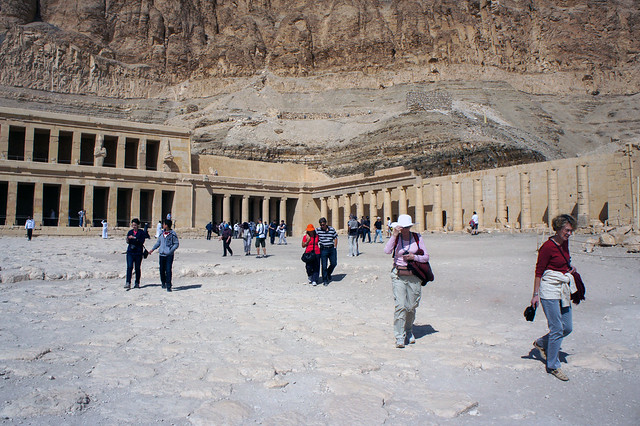 |
| Anubis shrine beside the North portico of the middle terrace |
I did not go inside it also, unfortunately.
Quick trips suck sometimes.
Now to the last ramp leading to the upper and final terrace but first we meet that Horus balustrade.
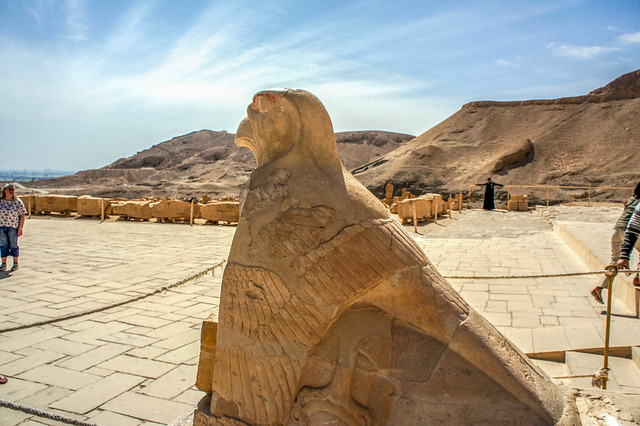 |
| Horus balustrade at the ramp-up to the upper terrace of Hatshepsut mortuary temple |
I wonder if there were balustrades in the other ramps that disappeared eventually thanks to time.
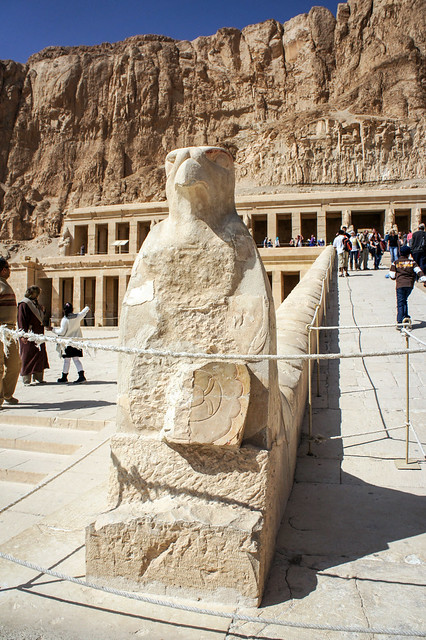 |
| The Hours balustrade at Hatshepsut temple |
That Horus is a hot attraction for visitors who love to sit below it to take photos to remember then move up to the upper and final terrace through the ramp/staircase.
 |
| The ramp between the middle and upper terraces of Hatshepsut mortuary temple You can see the green fields of Luxor on the horizon |
Here is an overview of the middle terrace from the upper trace.
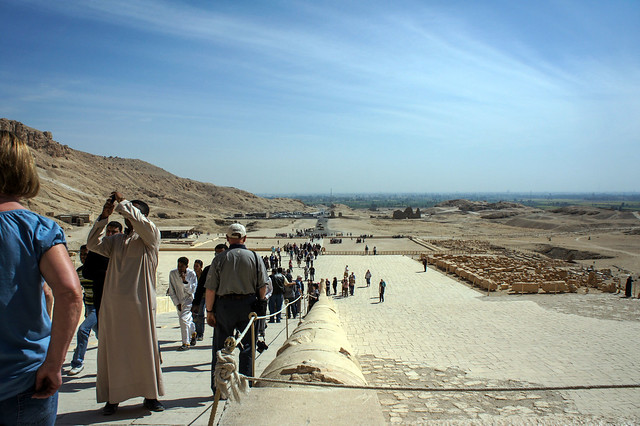 |
| The middle terrace from the upper terrace of Hatshepsut mortuary temple |
The Upper Terrace is made of 26 columns divided into 13 columns from the centre.
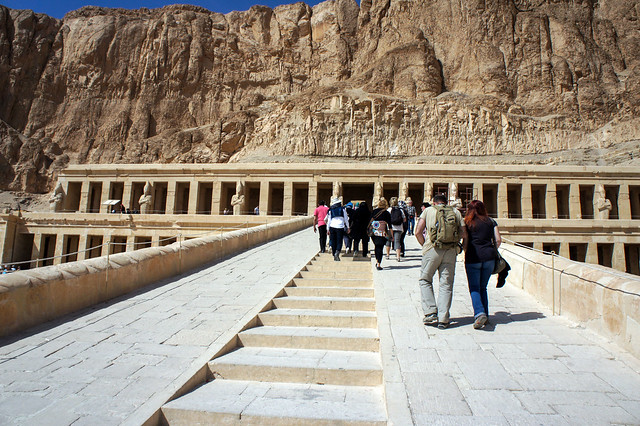 |
| The upper terrace colonnades at the upper terrace of Hatshepsut mortuary temple |
Most of them are fronted by a 5.2 m tall Osiride statue of Hatshepsut as a pharaoh, not as a Queen.
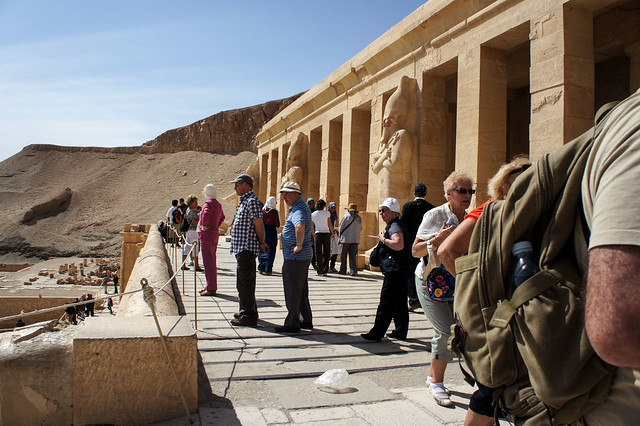 |
| Hatshepsut Osiride statues at the Upper terrace of Hatshepsut mortuary temple |
Some of those statues were destroyed by her stepson Thutmose III.
They have been renovated thousands of years later and the plan of the great ancient Egyptian military leader failed miserably.
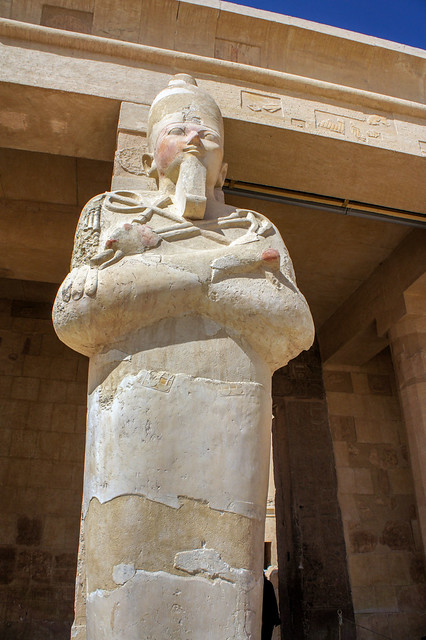 |
| Hatshepsut Osiride statues at the Upper terrace of Hatshepsut mortuary temple |
The world still remembers Hatshepsut and loves her too.
Interesting some of her statues at the Egyptian museum of Cairo were destroyed too.
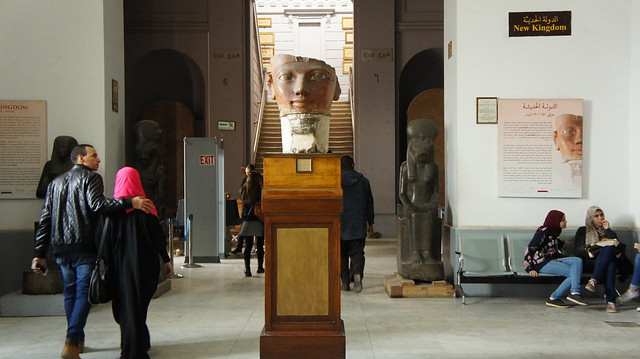 |
| The remains of a Hatshepsut statue at the New Kingdom section of the Egyptian Museum of Cairo |
she is more famous than him currently I believe.
 |
| The remains of a Hatshepsut statue at the New Kingdom section of the Egyptian Museum of Cairo |
Now we will leave Hatshepsut’s statues at the Egyptian Museum of Cairo and return back to her Mortuary Temple in Luxor.
I noticed that the columns had two shapes on the terrace, one row is square-shaped while the other one is circular.
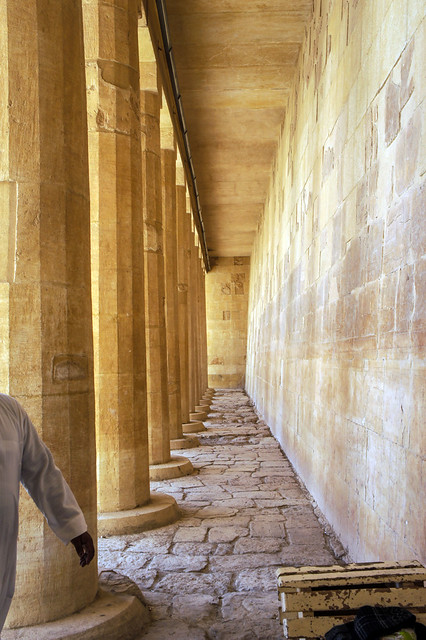 |
| Inside the upper terrace of Hatshepsut temple |
During our visit, the Polish archaeological expedition was continuing its work in renovating the ancient statues of the old Queen.
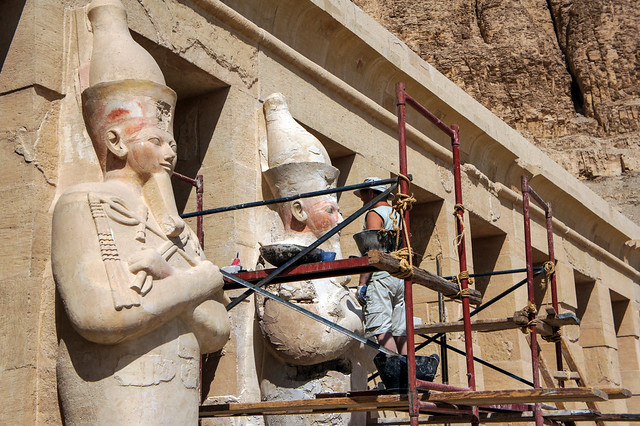 |
| Polish archaeologist during the renovation of Hatshepsut statues at her temple in 2012 |
The University of Warsaw’s Polish Centre of Mediterranean Archaeology has been participating in the restoration works of the Hatshepsut Mortuary temple since 1962 along with the Egyptian Supreme Antiquities council.
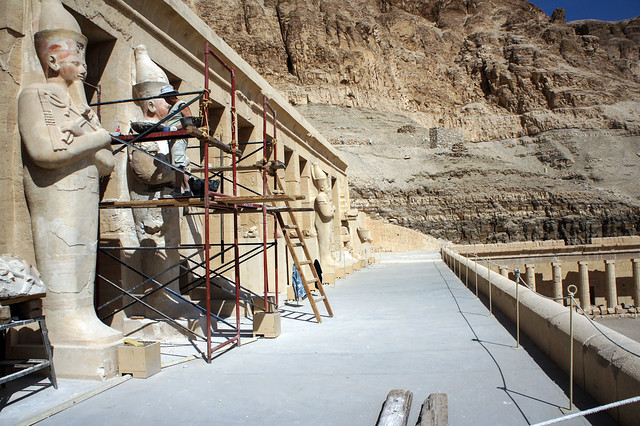 |
| Polish archaeologist during the renovation of Hatshepsut statues at her temple in 2012 |
From 1925 till 1952, the Egyptian Supreme Antiquities Council worked alone in the site and made a lot of discoveries.
The Upper terrace leads to the Upper courtyard or the festival courtyard.
 |
| At the entrance to the festival courtyard |
If you zoom in you can find a cartouche inscribed on that gate to the courtyard. I think it belongs to Thutmose II but I am not sure.
Thutmose II was the half brother and husband of Hatshepsut.
Inside there are remains of columns inside the court.
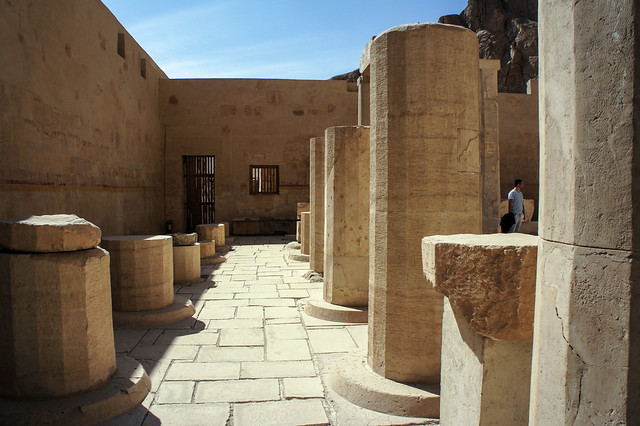 |
| The festival courtyard and the closed door leads to the Royal cult chapel |
That closed door you see on your right leads you to the Royal Cult chapel and beside it should be the mortuary cult complex.
In 2012, the Royal cult chapel and the mortuary cult complex were closed in front of visitors.
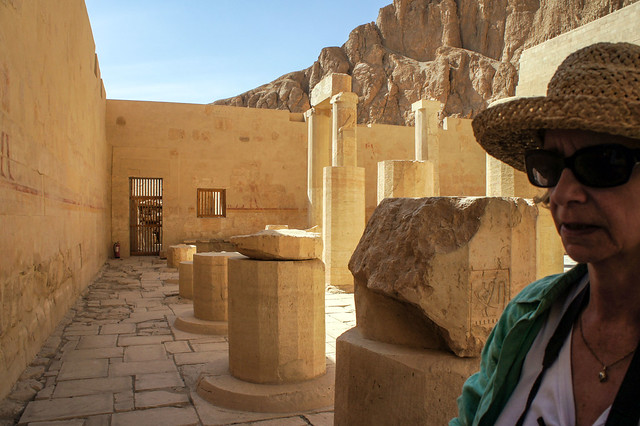 |
| The festival courtyard and the closed door leads to the Royal cult chapel |
Now in the festival courtyard, you will find yourself in front of Ptolemaic Portico, yes Ptolemaic Portico which leads you to the Amon Sanctuary and here we are in front of another Multi-layered Egypt.
 |
| Amon Ra sanctuary at the Ptolemaic Portico in the upper terrace of Hatshepsut Mortuary temple |
First I did not go inside again unfortunately but that Amon sanctuary is actually the heart of the temple and its holy of holies.
When it was built, there were two chambers and from outside the sanctuary is decorated with Hatshepsut's Osiride statues before they were damaged.
 |
| Amon Ra sanctuary at the Ptolemaic Portico in the upper terrace of Hatshepsut Mortuary temple |
A millennium later and during the era of Ptolemy III, a third chamber inside the sanctuary was reportedly for Greek deity Asclepios of medicine. It is an interesting choice but I am not familiar with the Ptolemaic era. Asclepios was of Apollo’s children and he was the god of medicine in the Greek methodology.
Asclepios is associated historically with ancient Egyptian genius architect-turned-into-a-god Imhotep.
Asclepios’ rod is actually till this day considered among the well-known symbols of medicines worldwide.
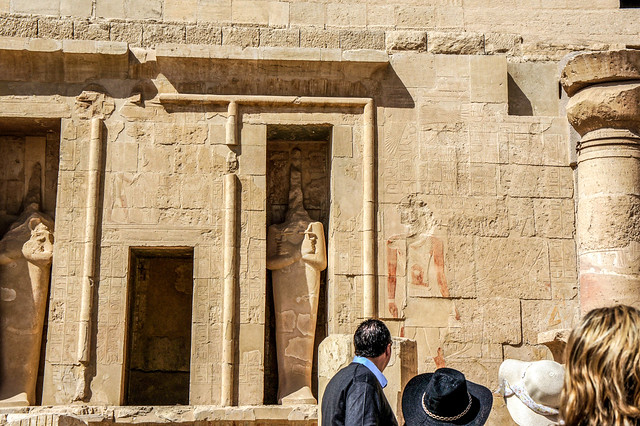 |
| More damaged Hatshepsut statues at the Ptolemaic Portico on the upper terrace of Hatshepsut Mortuary temple |
Thus comes the name of Ptolemaic portico despite there being fewer Ptolemaic traces here.
On the Northside of the Courtyard, there is a court dedicated to the solar cult but it was closed in front of visitors in 2012 too.
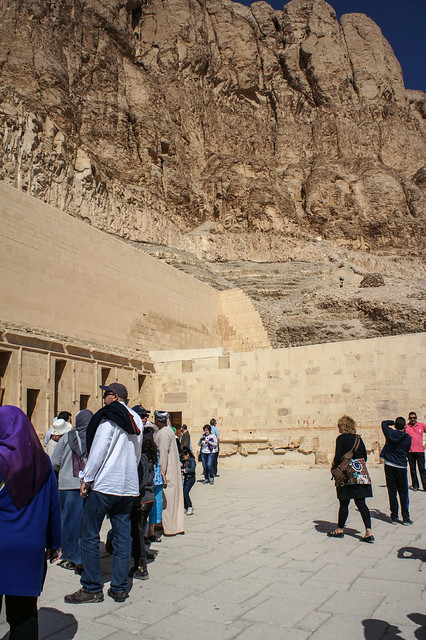 |
| The solar cult is located at the far right but its entrance was closed |
Now to the excavation digs, I can’t speak about Deir El-Bahry with speaking its famous Royal Cache aka TT320.
The Royal cache was discovered in 1874 by a couple of brothers from the local Abdel Rasoul clan of Qurna or as the Upper Egyptians pronounce it “Gurna” thanks to their goat and the rest is history.
 |
| The famous Qurna or Gurna village from the bus |
Then in 1881, Egypt’s first Egyptian official Egyptologist Ahmed Kamel made history in this arena when he examined officially the TT320 along German Emile Brugsch before French Gaston Maspero would come and lead one of the biggest discoveries of his time ever.
 |
| Haj Mohamed Abdel Rasoul with a rope, Gaston Maspero resting with an umbrella and |
The Royal Cache was a turning point in the history of archaeology and the role of Egyptians in it in this country when I think about it.
It is like history over history being made when I think about it.
More than 50 mummies of ancient Egyptian kings and Queens as well as VIPs were discovered in the cache or tomb that was originally used by the 20th dynasty in the Modern Kingdom.
We are speaking mummies from the 17th dynasty till the 20th dynasty including the famous 18th dynasty with Kings like Thutmose III, Ramses II and Ramses III.
The Royal Cache affair was dramatized in Shady Abdel Salam’s masterpiece “The Night of Counting the Years” which you must see.
The Royal cache mummies were sent displayed at the Egyptian Museum of Cairo for decades before they were transferred in that Golden parade which was held in April 2021.
I have not been able to pinpoint the location of the Royal Cache aka TT320 but I assume it was in that part of this area.
 |
| I think the TT320 is in this area |
Till now the area around the temple does not want to stop sharing more and more secrets.
This is the reason why there are many excavation digs surrounding the temple which you can spot so easily without camera zoom.
 |
| Excavation digs here and there at the temple in 2012 |
Now here is a very bad, short and shaky video for this amazing and beautiful temple. I am sorry for my voice in Arabic and I am sorry for this shaky video.
That’s it folks for Deir El-Bahry in 2012. Hopefully inshallah, I will return back to it again soon inshallah.
The photos and video were taken by Sony Nex 5 Camera with an 18-55 lens.

No comments:
Post a Comment
Thank You for your comment
Please keep it civilized here, racist and hateful comments are not accepted
The Comments in this blog with exclusion of the blog's owner does not represent the views of the blog's owner.